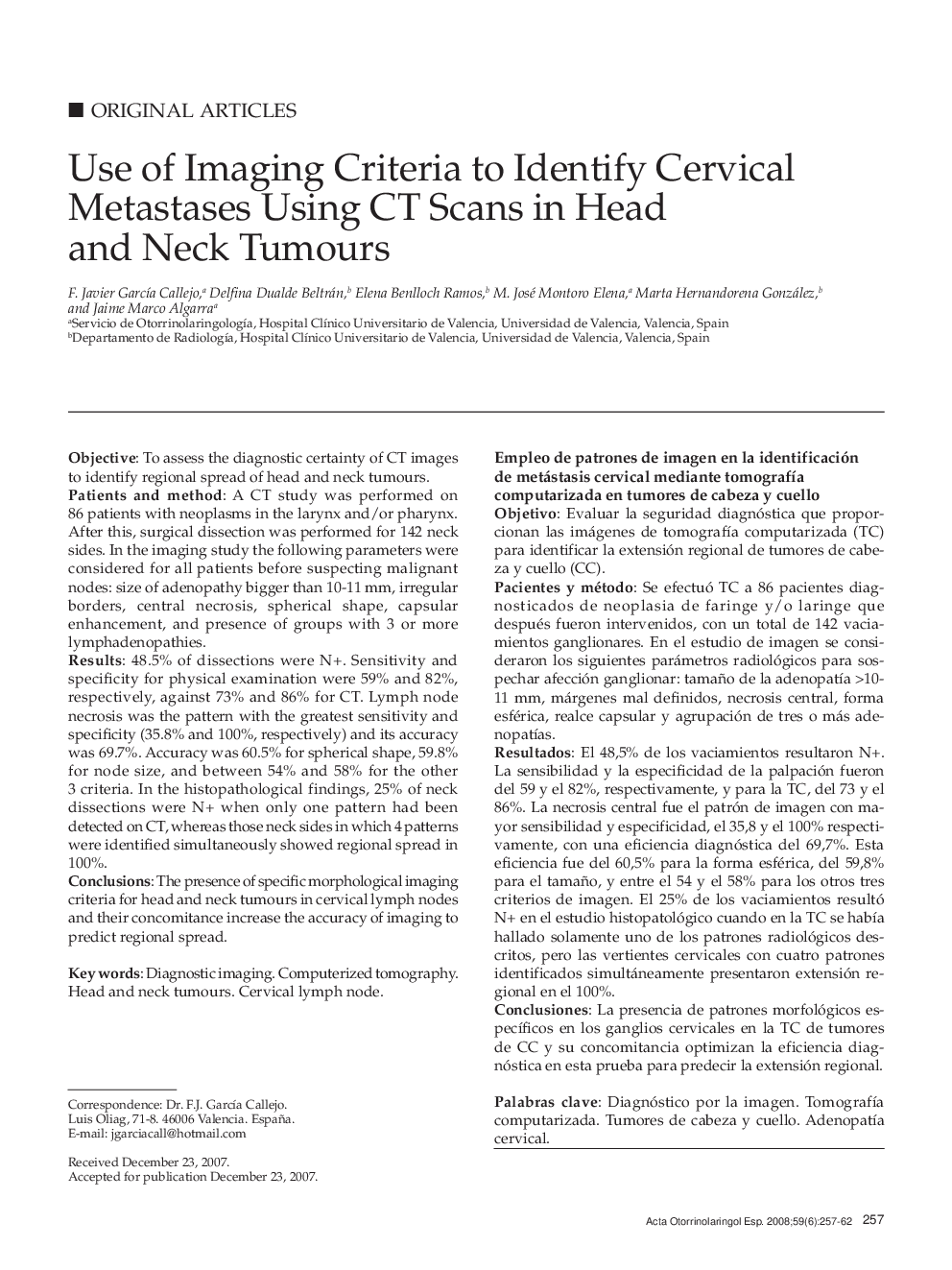| کد مقاله | کد نشریه | سال انتشار | مقاله انگلیسی | نسخه تمام متن |
|---|---|---|---|---|
| 4101306 | 1268757 | 2008 | 6 صفحه PDF | دانلود رایگان |

ObjectiveTo assess the diagnostic certainty of CT images to identify regional spread of head and neck tumours.Patients and methodA CT study was performed on 86 patients with neoplasms in the larynx and/or pharynx. After this, surgical dissection was performed for 142 neck sides. In the imaging study the following parameters were considered for all patients before suspecting malignant nodes: size of adenopathy bigger than 10–11 mm, irregular borders, central necrosis, spherical shape, capsular enhancement, and presence of groups with 3 or more lymphadenopathies.Results48.5% of dissections were N+. Sensitivity and specificity for physical examination were 59% and 82%, respectively, against 73% and 86% for CT. Lymph node necrosis was the pattern with the greatest sensitivity and specificity (35.8% and 100%, respectively) and its accuracy was 69.7%. Accuracy was 60.5% for spherical shape, 59.8% for node size, and between 54% and 58% for the other 3 criteria. In the histopathological findings, 25% of neck dissections were N+ when only one pattern had been detected on CT, whereas those neck sides in which 4 patterns were identified simultaneously showed regional spread in 100%.ConclusionsThe presence of specific morphological imaging criteria for head and neck tumours in cervical lymph nodes and their concomitance increase the accuracy of imaging to predict regional spread.
ResumenObjetivoEvaluar la seguridad diagnóstica que proporcionan las imágenes de tomografía computarizada (TC) para identificar la extensión regional de tumores de cabeza y cuello (CC).Pacientes y métodoSe efectuó TC a 86 pacientes diagnosticados de neoplasia de faringe y/o laringe que después fueron intervenidos, con un total de 142 vaciamientos ganglionares. En el estudio de imagen se consideraron los siguientes parámetros radiológicos para sospechar afección ganglionar: tamaño de la adenopatía >10–11 mm, márgenes mal definidos, necrosis central, forma esférica, realce capsular y agrupación de tres o más adenopatías.ResultadosEl 48,5% de los vaciamientos resultaron N+. La sensibilidad y la especificidad de la palpación fueron del 59 y el 82%, respectivamente, y para la TC, del 73 y el 86%. La necrosis central fue el patrón de imagen con mayor sensibilidad y especificidad, el 35,8 y el 100% respectivamente, con una eficiencia diagnóstica del 69,7%. Esta eficiencia fue del 60,5% para la forma esférica, del 59,8% para el tamaño, y entre el 54 y el 58% para los otros tres criterios de imagen. El 25% de los vaciamientos resultó N+ en el estudio histopatológico cuando en la TC se había hallado solamente uno de los patrones radiológicos descritos, pero las vertientes cervicales con cuatro patrones identificados simultáneamente presentaron extensión regional en el 100%.ConclusionesLa presencia de patrones morfológicos específicos en los ganglios cervicales en la TC de tumores de CC y su concomitancia optimizan la eficiencia diagnóstica en esta prueba para predecir la extensión regional.
Journal: Acta Otorrinolaringologica (English Edition) - Volume 59, Issue 6, 2008, Pages 257-262